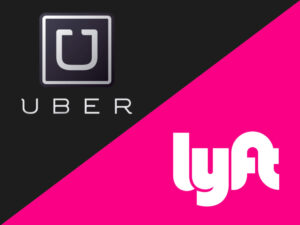
The Uber and Lyft ride-sharing services have become immensely popular and have turned the world of transportation nearly upside down. I was in Washington D.C. earlier this year and suggested to my daughter that we get a taxi to dinner after a long day of walking the monuments. She laughed, pulled out her cell phone and, after a few keystrokes, announced that our Uber was booked and that we needed to be outside the hotel in two minutes.
Uber and Lyft are amazingly convenient and affordable services. But, what happens when something goes wrong, an accident happens and there are injuries? Is the driver liable? What insurance do the drivers have to carry to protect passengers? Do Uber and Lyft provide extra coverage?
Here are the general rules regarding legal issues after an Uber or Lyft accident:
Private Insurance Carried by the Driver and Coverage When App is Off
An Uber or Lyft driver is required to have car insurance and must inform his/her insurance company that she is a ridesharing driver. Because of the greater risk involved for the insurance company, the insurance rates for an Uber/Lyft driver will be higher than regular insurance rates.
Currently, an Uber/Lyft driver can chose his/her own private car insurance limits, that is how much insurance he/she will have to cover injuries and damages done to others. In Pennyslvania, minimum limits for injury are $15,000 per person and $30,000 per accident and the minimum property damage liability coverage is $5,000. So, an Uber or Lyft driver may have low liability coverage limits. Those private insurance limits are the only coverage available when an Uber or Lyft driver is off duty and has the App off.
Uber/Lyft Supplemental Coverage
Both Uber and Lyft provide extra insurance coverage for their drivers that varies depending when an accident occurs that is when the App is on but no ride has been accepted and when the driver is en route or driving a paid passenger.
When App is On But No Trip Has Been Accepted
When the Uber or Lyft App is on but no trip has been accepted, both ridesharing services offer supplemental insurance that stacks on top of the driver’s policy. Specifically, the Uber/Lyft supplemental insurance covers $50,000 per person and $100,000 per accident for injury and $25,000 for property damage. So, if for example, an Uber driver had the App on but had not accepted a trip and got distracted and accidentally struck a pedestrian, the driver’s insurance would pay up to the limits of coverage (which in PA could be as low as $15,000) and Uber’s supplemental insurance would pay up to $50,000.
Because of the danger presented by Uber/Lyft drivers driving while looking at their phones and trying to accept rides, it has been argued that this coverage is inadequate and should be increased.
When a Trip Has Been Accepted and/or the Rider is in the Vehicle
After an Uber/Lyft ride has been accepted and the driver is either en route to pick up the rider or the rider is in the vehicle, the supplemental insurance provided by Uber/Lyft is greatly increased. During that time period, the supplemental insurance is $1 Million for Liability, $1 Million for Uninsured/Underinsured Coverage and property damage coverage to pay up to the actual value of the property minus a small deductible.
The $1 Million Liability coverage protects anyone injured by the driver, whether that be a ride share passenger, the driver or passengers in another vehicle involved in the accident or a pedestrian.
The $1 Million Uninsured/Underinsured Coverage protects the driver of the Uber/Lyft car vehicle and any ride share passengers in the event that they are injured by a hit-and-run driver, a driver who had no insurance or a driver who had insufficient insurance to cover the injuries in the accident. In those cases, the $1 Million of Uninsured/Underinsured coverage is available to an injured driver or passenger.
For example, assume that an Uber passenger is catastrophically injured in an accident that was caused by another driver who ran a red light and crashed into the Uber vehicle and that driver only had a $15,000 Liability policy. In that case, the injured passenger could collect the $15,000 from the other driver’s insurance and then make an Underinsurance claim against the Uber policy for up to $1 Million. If the passenger’s injuries were worth more than that coverage, then the passenger could also make a claim for any Underinsurance coverage that he/she had on his/her personal car insurance policy. (As an aside, please make sure that you have Uninsured/Underinsured coverage of at least $100,000 and preferably much more on your car insurance policy.)
Viability of Claims in Excess of the Uber/Lyft Supplemental Insurance
In truly catastrophic injury cases that have damages in excess of the $1 Million supplemental coverage, litigation has been filed against Uber/Lyft and its drivers for negligence seeking additional compensation. Those cases are complicated because Uber/Lyft argue that its drivers are independent contractors rather than employees. Each case should be evaluated by an experienced car accident lawyer to determine whether or not there is an opportunity to recover more than the driver’s insurance and the Uber/Lyft supplemental insurance.
To schedule a free consultation and learn more about your rights, contact Pennsylvania car accident lawyer Tim Rayne at 610-840-0124 or [email protected], or check out Tim’s website at www.timraynelaw.com. Tim has over twenty years of experience helping injured accident victims receive fair treatment from insurance companies. Tim has an advanced Master’s Degree in Trial Advocacy and is Board Certified by the National Board of Trial Advocacy. Tim regularly practices in Chester County, with offices in Kennett Square and West Chester. He also helps clients with cases in neighboring counties, including Bucks County, Delaware County, Lancaster County, Montgomery County and Philadelphia County.
Read: Ten Steps to Follow if You Are Injured in a Car Accident in Pennsylvania





